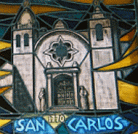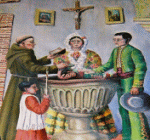Blessed Junipero Serra &
the California Missions 
|
Frequently Asked Questions | ||
|
Other Information /Links | ||
|
Junipero Serra and the California Missions Junipero Serra is an
extremely important figure in the development of present-day
California. His missions not only served as the centerpiece to the
development of Catholicism in California, but also as a key
foundation to the growth of metropolitan cities such as San
Francisco, San Jose, and San Diego. His legacy still remains along
the former El Camino Real (the present day Hwy 101&San Diego
Freeway) in the form of twenty-one missions, nine of which he
personally founded and developed. Each has its own individual
identity, history, and unique traditions. The California MissionsThe Mission System was implemented by Serra and
the Franciscans under the guidelines of the Catholic Church and the
Spanish government. They were set up not only to become the
primary center of evangelization to Christianize the Native
Americans, but also were designed to train the natives to become
successful tradespeople in the new Spanish society. The
natives were welcomed by the missionaries into the mission system
and joined the Catholic Church through baptism. Then they were
catechized, confirmed, and often married at the mission; all for the
salvation of their souls. Each mission was built in a quadrangle for security (from the outside). The mission included a prominent church, rooms for priests, storehouses, housing for unmarried women, soldier barracks, dining facilities, and indoor workshops. Married Indians lived in a village within close proximity to the mission. Keep in mind that at no time did the Franciscans see mission land as their land, but as land rightfully belonging to the Natives to be handed over when they were comfortably acculturated to society and Christianity. In addition to evangelization, the missionaries helped to improve the lives of the natives by introducing new and more reliable food sources than they previously had; most notably the modern (18c.) agricultural system of raising crops and livestock. What was produced by the mission benefited the mission population directly or through trade. The Indians certainly faced terrible hardship adjusting to this new way of life. They mainly suffered from abusive soldiers who were responsible for the spreading of diseases, such as pox and syphilis, and the mistreatment of Indians (though many unfairly blame Serra for the abuses). Serra tried to prevent the devastating effects, but knew the overall system would benefit the Indians. It is true when one looks at it from an anthropological view, the mission system seems inhumane. But we must remember we are looking at it through a twentieth century viewpoint. When one realizes:
then one can understand and appreciate the reason Serra and his fellow missionaries saw the importance of the mission system for the native population. The claims by anti-Serra activists of Indian whippings were really comparable to a slap on the wrist (which was a common punishment in Spanish society for disobedience). The reality of the mission system was:
Serra’s Care for the Native AmericansSerra saw the mission system as the best way of not only evangelizing the Christian message, but also keeping the Indians safe from the Spanish conquest of Alta California. Indirectly, Serra made it easier for the empire to take hold of California, but Serra’s concern was more for the personal welfare of each native person.
The fact is that Serra was not out to destroy the Indian society, but to protect it. This is exemplified in his call for Indian Rights. Outraged over the abuses by the soldiers, especially military commander Pedro Fages, Serra traveled to Mexico City in 1773 to propose what some would call a ‘bill of rights’. He called for complete missionary charge of the Indians and the removal of Fages. The Viceroy (the king’s representative in the ‘New World’) granted both requests which lead the way for the Indians to be treated fairly and justly along with enabling the missionaries to evangelize more effectively. Many activists have claimed Serra to have been a very unholy man who beat and tortured Indians. But there has never been one piece of historical documentation to prove any of their claims. (In fact, if any proof existed, his canonization process would be halted.) Expert, unbiased historians, after piecing through all the historical documentation and other evidence, have confirmed no abuses or mistreatment have occurred by Serra. But it is a true injustice that thehistorical facts of Serra’s life and the California Mission system today are still tainted by wild opinion and speculation of activists without any attempt to substantiate their claims. This leads to confusion in the public spectrum and a history based on a complete misrepresentation of the truth and the reality of this time period. (By truth, I am referring to facts; by reality, I am referring to the social, political, economic, and religious situation of Spanish society.) The only conclusive historical
evidence that can be proven is that Blessed Junipero Serra was a
zealous Copyright 1997-2007 by Brian Grisin Questions or Comments: calmission@gmail.com
Serra Prayer for Canonization: O Lord Jesus Christ, reward the apostolic zeal of your Seraphic son, Blessed Junipero Serra, who leaving his home and fatherland, labored for the salvation of souls in Spain, Mexico, and California. By Your Most Holy Name may he be raised to the full honors of the altar. Through the intercession of Blessed Serra, look with favor on my special prayers which have no earthly answer. This we pray through Christ our Lord. Amen. |
|






 Keeping in
mind the attitudes of the day, Serra went above-and-beyond his contemporary historical evangelizers and
pioneers. He should be viewed in California history as one who truly cared for the
Indians. When we look at other societies of this time period, we find
there was no toleration for the Native Americans. For instance, just one century
after Serra founded the missions, the American government gave the
public the right to kill “wild” Indians who were “in the way”. (This
makes you wonder what would have happened to the natives if the
Americans came before the Spanish!)
Keeping in
mind the attitudes of the day, Serra went above-and-beyond his contemporary historical evangelizers and
pioneers. He should be viewed in California history as one who truly cared for the
Indians. When we look at other societies of this time period, we find
there was no toleration for the Native Americans. For instance, just one century
after Serra founded the missions, the American government gave the
public the right to kill “wild” Indians who were “in the way”. (This
makes you wonder what would have happened to the natives if the
Americans came before the Spanish!)  missionary devoted to the spread of the Gospel
Message. He taught and lived out the Gospel message, converted
thousands of Native Americans to Christianity, and was a strong and
courageous leader of the natives who constantly fought for their
rights and provided them with the means for adapting in this new
society. Pope John Paul II remarks that Serra “is an exemplary model
of a selfless evangelizer, a shining example of Christian virtue and
the missionary spirit...He not only brought the Gospel message to
the Native Americans, but as one who lived the Gospel he also became
their defender and champion”.
missionary devoted to the spread of the Gospel
Message. He taught and lived out the Gospel message, converted
thousands of Native Americans to Christianity, and was a strong and
courageous leader of the natives who constantly fought for their
rights and provided them with the means for adapting in this new
society. Pope John Paul II remarks that Serra “is an exemplary model
of a selfless evangelizer, a shining example of Christian virtue and
the missionary spirit...He not only brought the Gospel message to
the Native Americans, but as one who lived the Gospel he also became
their defender and champion”. 




